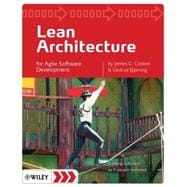
Note: Supplemental materials are not guaranteed with Rental or Used book purchases.
Purchase Benefits
Looking to rent a book? Rent Lean Architecture for Agile Software Development [ISBN: 9780470684207] for the semester, quarter, and short term or search our site for other textbooks by Coplien, James O.; Bjørnvig, Gertrud. Renting a textbook can save you up to 90% from the cost of buying.
Gertrud Bjornvig is an experienced software consultant and trainer and has been in software development since 1984. She's been working on development teams as a developer, analyst, and project manager, and has had cross-organizational roles as methodologist and process consultant. Her background is in object-oriented development, including extensive work with UML and RUP. Gertrud has been employed by Enator, Navision, Microsoft, and TietoEnator, but since June 2007 she has been independent as a part of Gertrud & Cope.
Gertrud holds a Master in Computer Science and Communication and is one of the founders of Danish Agile User Group.
| About the Authors | |
| Preface | |
| Introduction | |
| The Touchstones: Lean and Agile | |
| Lean Architecture and Agile Feature Development | |
| Agile Production | |
| The Book in a Very Small Nutshell | |
| Lean and Agile: Contrasting and Complementary | |
| Lost Practices | |
| What this Book is Not About | |
| Agile, Lean - Oh, Yeah, and Scrum and Methodologies and Such | |
| History and Such | |
| Agile Production in a Nutshell | |
| Engage the Stakeholders | |
| Define the Problem | |
| Focusing onWhat the System Is: The Foundations of Form | |
| Focusing onWhat the System Does: The System Lifeblood | |
| Design and Code | |
| Countdown: 3, 2, 1. . . . | |
| Stakeholder Engagement | |
| The Value Stream | |
| The Key Stakeholders | |
| Process Elements of Stakeholder Engagement | |
| The Network of Stakeholders: Trimming Wasted Time | |
| No Quick Fixes, but Some Hope | |
| Problem Definition | |
| What's Agile about Problem Definitions? | |
| What's Lean about Problem Definitions? | |
| Good and Bad Problem Definitions | |
| Problems and Solutions | |
| The Process Around Problem Definitions | |
| Problem Definitions, Goals, Charters, Visions, and Objectives | |
| Documentation? | |
| What the System Is, Part 1: Lean Architecture | |
| Some Surprises about Architecture | |
| The First Design Step: Partitioning | |
| The Second Design Step: Selecting a Design Style | |
| Documentation? | |
| History and Such | |
| What the System Is, Part 2: Coding It Up | |
| The Third Step: The Rough Framing of the Code | |
| Relationships in Architecture | |
| Not Your Old Professor's OO | |
| How much Architecture? | |
| Documentation? | |
| History and Such | |
| What the System Does: System Functionality | |
| What the System Does | |
| Who is Going to Use Our Software? | |
| What do the UsersWant to Use Our Software for? | |
| Why Does the UserWant to Use Our Software? | |
| Consolidation ofWhat the System Does | |
| Recap | |
| "It Depends": When Use Cases are a Bad Fit | |
| Usability Testing | |
| Documentation? | |
| History and Such | |
| Coding It Up: Basic Assembly | |
| The Big Picture: Model-View-Controller-User | |
| The Form and Architecture of Atomic Event Systems | |
| Updating the Domain Logic: Method Elaboration, Factoring, and Re-factoring | |
| Documentation? | |
| Why All These Artifacts? | |
| History and Such | |
| Coding it Up: The DCI Architecture | |
| Sometimes, Smart Objects Just Aren't Enough | |
| DCI in a Nutshell | |
| Overview of DCI | |
| DCI by Example | |
| Updating the Domain Logic | |
| Context Objects in the User Mental Model: Solution to an Age-Old Problem | |
| Why All These Artifacts? | |
| Beyond C++: DCI in Other Languages | |
| Documentation? | |
| History and Such | |
| Epilog | |
| Scala Implementation of the DCI Account Example | |
| Account Example in Python | |
| Account Example in C# | |
| Account Example in Ruby | |
| Qi4j | |
| Account Example in Squeak | |
| Testing Perspective | |
| Data Perspective | |
| Context Perspective | |
| Interaction (RoleTrait) Perspective | |
| Support Perspective | |
| Bibliography | |
| Index | |
| Table of Contents provided by Publisher. All Rights Reserved. |
The New copy of this book will include any supplemental materials advertised. Please check the title of the book to determine if it should include any access cards, study guides, lab manuals, CDs, etc.
The Used, Rental and eBook copies of this book are not guaranteed to include any supplemental materials. Typically, only the book itself is included. This is true even if the title states it includes any access cards, study guides, lab manuals, CDs, etc.